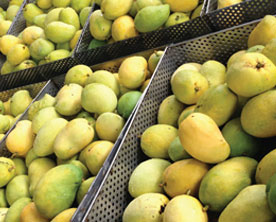The aroma is incredible and sniffing them is a treat in itself. If you are a mango lover, you know what I am talking about. Sein Ta Lone mangoes from Myanmar are known for its superior and distinct fragrance and anyone and everyone who has tasted it once never forgets its deliciousness. Myanmar’s Sein Ta Lone (meaning Diamond Solitaire) mango seems to have become a rage not only with the locals but with the foreigners, as well. No wonder the famous and most popular man- go variety is in high demand in other Asian markets including China and Singapore. The Myanmar Fruit and Vegetable Producers and Exporters Association’s chairman, Soe Than Min Din, outlined that the export of mangoes to Singapore has increased significantly after the trade links with China have been established once again. Fresh mangoes are mainly exported to China by border trade and to Singapore by overseas trade.
In Myanmar, about 300 varieties and 20 kinds of mango species are grown. Some known ones are Machitsu, Yingwe, Pannswe, Thone-lone-tataung, and so on. But Sein-talone is the best in taste which is not available in any other country. Given the increasing demand, more and more people have started growing Sein Ta Lone man- goes. Till a few years back, it was cultivated only in the hilly region, but now the experts are researching the ground to plant it in other regions as well. “We have sent 3 tonnes of mangoes to Singapore and Malaysia and will be exporting more depending on our capacity till the season ends,” says Kim Young, an employee of a fruit exporting company.
The deliciousness and sweet fragrance of Myanmar’s mangoes have lured South Koreans, as well. So far, South Korea was importing mangoes from The Philippines and Vietnam, but since the fruit has become very popular in the country, it has decided to allow mango imports from Myanmar very soon.
Mango is not the only fruit that Myanmar is exporting to its neighbours but water- melons and muskmelons are equally in demand. . Myanmar is rich with tropical fruit resources such as mango, banana, pineapple, strawberry, durian, mangosteen, papa- ya, tamarind, and coconut. Other commonly grown deciduous fruits such as the damson plum, Japanese apricot and persimmon are also exported, albeit not in large numbers. Plum and Japanese apricot are usually produced and preserved and used as dehydrated and salted preparations, locally
Myanmar’s fruit exports hit US$23 million within the first two months of the fiscal year of 2013-14, according to the Ministry of Commerce. Among the exported fruits, watermelons and mangoes are the most popular. Over 70,000 tonnes of watermelons and 14,000 tonnes of mangoes were exported mainly to China and Singapore. Malaysia and Thailand are two new export markets. Besides, Myanmar has started participating in international fruit festivals around the world.
“Seedless watermelons have been traded to China through the border for five years. We earlier attempted to export them with air shipment, but failed to do so due to the fruits’ weight. Now, we have started sea shipments to Singapore,” says Young. “This is more profitable than trading watermelons through the border.”
The reason for the demand of Myanmar watermelons abroad is that they are big, juicy and sweet. Despite the popular belief that watermelon is made up of only water and sugar, watermelon is actually considered a nutrient dense food, a food that provides a high amount of vitamins, minerals and anti-oxidants for a low amount of calories.
Myanmar watermelons and musk melons have become a hot product in the domestic Chinese fruit market. In Wanding in China, a ton of Myanmar muskmelons is priced at 18,000 Yuan in a fruit wholesale market. “At that price you can buy a ton of mahogany in the local area” dealers in fruits exports say. Trucks from Myanmar and the mainland fill the wholesale markets with fruits, affecting the traffic at Wanding. This clearly shows the booming agricultural cooperation along the China-Myanmar border. Water melons are grown from October to January in Myanmar.
The border of the Ruili region in northeastern Myanmar has a lot of land but with a few people.
The soil of this region is fertile and there is abundant rainfall and sunshine. The conditions are very suitable for growing tropical fruits. Therefore, the watermelons and musk melons produced here are big, juicy, sweet, and have been very popular in the domestic fruit market. Around the late 80’s and early 90’s, mainland fruit growers started leasing land to plant watermelons to sell them in the mainland. As city construction began to develop, the original small Ruiwan area of agricultural land began to get crowd- ed. So the fruit growing local farmers began to go out of China, near the border to Myanmar and plant fruits there.
With the arrival of Chinese farmers bringing in capital and technology to Myanmar, the original large areas of wasteland have now begun to produce economic benefits to the local people. Many Myanmar locals who at first started to work for Chinese growers and planted melons, have now have learned how to use the land, invest capital and how to be partners. Currently, there are nearly a thousand Chinese farmers in Myanmar engaged in traditional agricultural planting who after harvest sell the products in the China market.
Myanmar commerce authorities have urged farmers in the country to expand export of fruits to boost foreign exchange earnings, particularly the export of mango, watermelon and musk melon. Previously these fruits were harvested three months in a year but now it’s a year round process which is a clear proof of Myanmar’s fruits’ growing demand across its borders.










